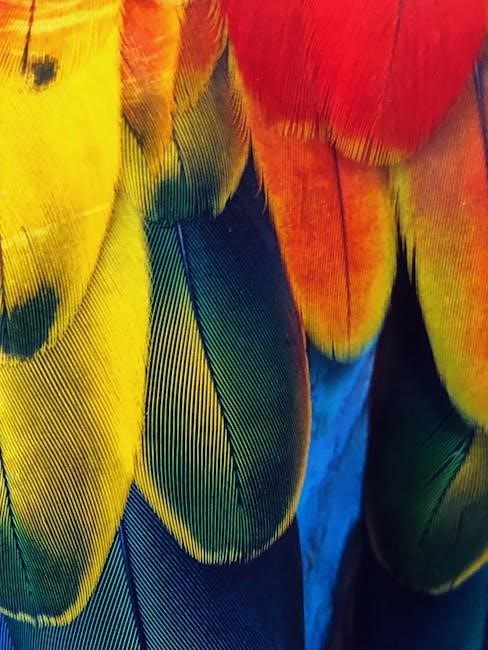The Rainbow Passage is a typographical example showcasing color gradients, originating as a demonstration tool. It structures text to illustrate vibrant color transitions, thereby enhancing visual engagement.
Origin and Purpose
The Rainbow Passage was originally designed as a typographical demonstration, showcasing vibrant color gradients and smooth transitions. Its primary purpose is to display how text can visually represent a spectrum of colors seamlessly. Created for educational and design purposes, it serves as a tool to illustrate advanced typography and color theory principles. The passage is widely used in graphic design and printing to test color accuracy and consistency across different mediums. Its origins trace back to early desktop publishing efforts, where it became a standard example for demonstrating color application in text.
Structure and Content
The Rainbow Passage is structured as a single, concise paragraph that transitions through a spectrum of colors, typically following the order of the rainbow. Its content is minimal, focusing on a brief, neutral narrative about rainbows, designed to avoid distracting from its visual purpose. The passage is short, making it ideal for typographical demonstrations. It is often used in PDF formats to showcase color gradients and test printing accuracy. The text flows smoothly, with each sentence gradually shifting to a new color, creating a seamless visual effect. This structure allows it to serve as an effective tool for both design and educational purposes.

Analysis of the Rainbow Passage
The Rainbow Passage is a typographical demonstration showcasing vibrant color gradients, effectively illustrating how text can visually engage while maintaining readability, making it a popular tool in design testing.
Literary Devices and Themes
The Rainbow Passage employs vibrant color gradients to symbolize diversity and harmony, using imagery to evoke emotions tied to the beauty of rainbows. Its structure and themes emphasize the interplay of light and color, creating a visually engaging narrative. The passage explores themes of clarity, vibrancy, and the universal appeal of natural phenomena, making it a powerful tool for both typographical and literary expression. Through its use of repetition and gradual color transitions, it conveys a sense of balance and aesthetic appeal, highlighting the connection between visual design and textual meaning. This makes it a enduring example of how form enhances function in communication.
Symbolism and Metaphors
The Rainbow Passage is rich in symbolism, representing hope, diversity, and the natural beauty of spectral colors. Each color gradient symbolizes a transition, reflecting the harmony and balance found in nature. The passage often serves as a metaphor for unity in diversity, as the blending of colors creates a cohesive whole. It also symbolizes clarity and vibrancy, emphasizing how individual elements contribute to a larger, meaningful structure. The rainbow motif itself is a universal symbol of promise and renewal, making the passage a powerful representation of both visual and thematic depth.
Educational Use of the Rainbow Passage
The Rainbow Passage is widely used in classrooms to teach color theory, typography, and design principles, showcasing how text can be enhanced with vibrant color gradients.
Reading Instruction
The Rainbow Passage is often utilized in reading instruction to enhance fluency and engagement; Its colorful, gradient-based text encourages students to focus on word recognition and pronunciation. Teachers use it to demonstrate how visual cues can aid comprehension, making complex texts more accessible. The passage’s structure, with its gradual color transitions, helps learners associate colors with emotions and themes, fostering deeper connections to the material. This tool is particularly effective in early literacy programs, as it makes reading a more interactive and enjoyable experience for students of all ages and skill levels.
Language Learning
The Rainbow Passage serves as a vibrant tool for language learning, enhancing engagement through its colorful, gradient-based text. It helps learners focus on word recognition and pronunciation while associating colors with emotional tones and themes. The passage’s structure often highlights grammatical patterns and vocabulary in a visually appealing way, making it easier for language learners to grasp complex sentence structures. Additionally, it can incorporate cultural references, aiding in the comprehension of idiomatic expressions and cultural nuances. This interactive approach makes language acquisition more dynamic and accessible for learners at various proficiency levels.

Cultural Impact of the Rainbow Passage
The Rainbow Passage has become a cultural symbol, representing diversity and vibrancy. Its use in educational materials and artistic designs highlights its enduring influence on visual communication.
Cultural Significance
The Rainbow Passage holds profound cultural significance as a symbol of diversity and vibrancy. Its vivid color transitions represent unity in variety, making it a popular tool in design and education. Widely used in typographical demonstrations, it inspires creativity and visual engagement. The passage has been adapted in various media, from art projects to educational materials, showcasing its universal appeal. Its ability to convey complex ideas through simplicity has cemented its place in cultural and educational contexts, influencing visual communication globally.
Historical Background
The Rainbow Passage has its roots in early typographical experiments, emerging as a vibrant display of color gradients. Originally designed to showcase printing techniques, it gained popularity in the mid-20th century as a tool for demonstrating chromatic transitions. Over time, its use expanded into educational materials and digital design, where it remains a staple for illustrating visual hierarchy and readability. Its evolution reflects advancements in printing and digital technology, making it a timeless example of how text can be both functional and aesthetically pleasing. The passage continues to inspire designers and educators, bridging tradition with modern innovation.

Effective Reading Techniques
Effective reading involves strategies like visualization, context clues, and phonics. The Rainbow Passage aids in developing these skills, enhancing engagement and fluent reading comprehension through its structured design.
Practice Strategies
The Rainbow Passage is often used to enhance reading fluency through consistent practice. Educators recommend guided reading sessions, where learners read aloud and receive feedback. Repetition is key, as it builds familiarity and confidence. Timed readings help track progress, while recording sessions allow for self-assessment. Technology tools, like text-to-speech software, can also aid in improving intonation and pacing. Additionally, breaking the passage into smaller sections and gradually increasing difficulty ensures a structured approach. These strategies foster a deeper connection with the text, making practice both effective and engaging for learners of all levels.
Fluency Development
The Rainbow Passage is widely recognized as a powerful tool for enhancing reading fluency. Its rich vocabulary and varied sentence structures encourage learners to focus on rhythm and intonation, fostering a natural flow. By repeatedly reading the passage, individuals improve their ability to read smoothly and with confidence. The text’s engaging content also motivates learners to practice consistently, leading to better pacing and accuracy. Over time, this practice helps develop a more expressive and effortless reading style, making the Rainbow Passage a valuable resource for fluency development in educational settings.
Key benefits include improved rhythm, enhanced expression, and increased reading confidence.

Challenges and Controversies
The Rainbow Passage has faced criticism for its traditional approach, with some arguing it lacks modern relevance. Debates also arise over its cultural bias and limited diversity.
These issues spark ongoing discussions about its effectiveness in contemporary education.
Criticism and Debates
The Rainbow Passage has sparked debates over its effectiveness and relevance in modern education. Critics argue that its traditional structure and lack of interactivity make it less engaging for contemporary learners. Some educators question its cultural bias, as the content may not resonate with diverse student backgrounds. Additionally, the passage’s focus on visual aesthetics over substantive content has led to criticism that it prioritizes form over function. These debates highlight the challenges of balancing artistic expression with educational practicality, raising important questions about its role in today’s classrooms.
Modern Relevance
The Rainbow Passage remains a significant tool in modern education, particularly in reading and language instruction. Its vivid imagery and structured progression make it ideal for demonstrating color theory and typographical design. In digital age, its relevance extends to graphic design and visual communication, where it is often used to showcase color gradients and text formatting. Educators continue to appreciate its versatility, incorporating it into lessons on literacy and aesthetic appreciation. Despite its traditional origins, the passage adapts well to contemporary learning environments, proving its enduring value in both educational and creative contexts.
Examples and Illustrations
The Rainbow Passage is often illustrated with vibrant color gradients, showcasing its typographical appeal. PDF versions highlight its use in design and education, demonstrating visual engagement effectively.
Passage Excerpts
Excerpts from the Rainbow Passage often highlight its vivid color transitions, such as the iconic sentence: “The rainbow is a beautiful natural phenomenon.” These snippets are frequently used in PDF versions to demonstrate typographical appeal and educational value. The passage’s structured text showcases gradients, making it a popular tool for design and readability studies. Many excerpts emphasize its role in teaching color theory and visual engagement. PDF downloads often include annotated versions, explaining how the passage enhances comprehension through visual cues. These excerpts are widely used in classrooms and design workshops to illustrate effective text presentation techniques, making the Rainbow Passage a versatile educational resource.
Visual Interpretations
The Rainbow Passage is often accompanied by visual interpretations that enhance its typographical appeal. These include color-coded diagrams, gradient illustrations, and graphical representations of its text. PDF versions frequently incorporate images and charts to emphasize the passage’s thematic elements, such as the spectrum of colors in a rainbow. Visual enhancements like infographics and annotated diagrams further illustrate its educational purpose, making it a versatile tool for both design and learning. The passage’s visual adaptations are widely shared in PDF formats, offering a dynamic way to engage with its content.
The Rainbow Passage serves as a vibrant typographical tool, demonstrating color gradients and enhancing visual engagement. Its educational and design applications make it a timeless resource in PDF formats.
The Rainbow Passage is a typographical tool showcasing color gradients, widely used in design and education. It demonstrates vibrant color transitions, enhancing visual engagement. Originally created for typographical demonstrations, it has gained popularity in PDF formats for its aesthetic appeal. The passage is valued for its ability to illustrate complex color theory concepts simply. It serves as a timeless resource for educators and designers, offering both functional and artistic value. Its availability in PDF ensures accessibility for global use, making it a versatile tool for various applications.
Final Thoughts
The Rainbow Passage remains a timeless and versatile resource, offering both aesthetic and educational value. Its use of vibrant color gradients makes it a powerful tool for design and learning. Widely available in PDF format, it continues to inspire educators and designers globally. The passage not only demonstrates complex color theory but also serves as a beautiful typographical example. Its enduring popularity highlights its adaptability and relevance in modern applications. Whether for educational purposes or creative inspiration, the Rainbow Passage is a cherished and enduring asset in the realm of visual and typographical expression.
